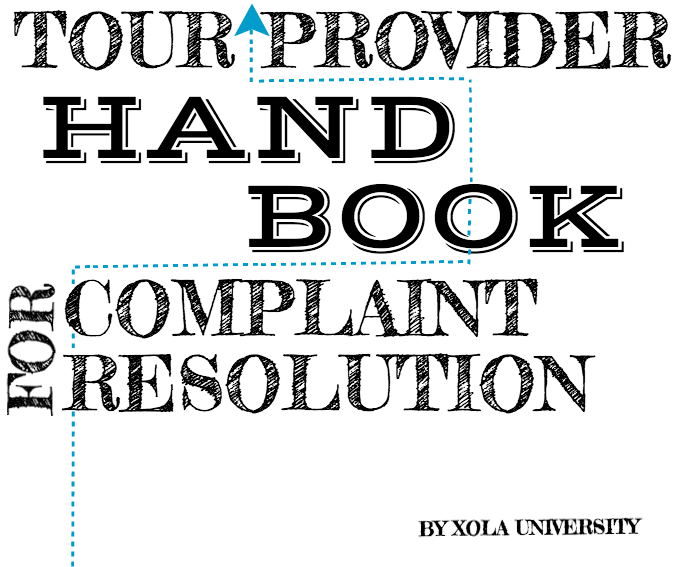

Bad news travels much faster than good. A dissatisfied customer will tell between 9-15 people about their experience (White House Office of Consumer Affairs). Around 13% of dissatisfied customers tell more than 20 people. What’s perhaps worse, a recent survey suggests that 26 percent of travelers 34 and younger indicated they would leave a negative review after a bad experience (14% of travelers 35 and older felt the same way). When a potential quarter of your customers are apt to write negative reviews, it is time to sit up and listen.
To ensure that your tour business handles complaints well, take the time to set up complaint resolution procedures. Make sure that everyone in your organization understands the protocol for varying degrees of dissatisfaction. This article helps your company dial in effective and efficient complaint resolutions processes based on best practices around the industry.
Categorize Complaint Levels
Not all complaints are equally important. For a complaint about relatively trivial issues (there were tulips in the promotional video but azaleas were the only flower in bloom on the tour), you should still proceed with caution and care, but also with a realistic view on what you can actually do to amend this sense of slight. In a case such as this, the staff responding to the complaint should be open, honest and considerate – even apologetic – but also reasonable.
Offers to make amends may consist of future notice when tulips are in season – perhaps an early reservation code or booking notification – or a simple coupon or credit for a small trinket or feature, such as a brunch or quality photo opportunity.
The important thing to note is that these events are opportunities to create trust and cultivate a loyal customer. The issue is small — it’s likely that the guest just wants to be heard and have her gripe acknowledged. By remaining apologetic and considerate, along with offering a small perk, you can turn a complaint into a second chance.
Managing Larger Issues
When more serious incidents arise, always keep two goals in mind:
- Retain or create as many loyal, repeat customers as possible
- Avoid any PR ripples, including bad press or reputation problems
When a guest reports a notable offense (e.g. your staff was rude or you failed to provide what you promised), you need to act quickly to mitigate the problem as much as possible.
Remember that response speed can often be more important than the actual compensation offered. Don’t let the customer dwell on the problem longer than necessary. This means that if you know something about the problem before receiving a complaint, don’t wait for the customer to raise the issue. Not all will air their grievances to you, but they will most certainly recount their experiences with their friends–or worse, their entire social networks. Now 500+ Facebook friends and 300+ Twitter followers are privy to one person’s misfortune, which can seriously jeopardize a tour’s reputation. Why risk the fallout when you can cut it off at the pass?
By confronting the problem at the start, you’ll prove that you’re not afraid to identify a mistake, own up to it and make amends quickly. This can go a long way toward preventing any public problem and can instead promote your company’s honesty, trustworthiness and decency.
So whether your entire group got food poisoning one night or a showcase event was canceled at the last minute, the first step in your complaint resolution procedures should be to act immediately and not wait until the complaints and expectant looks come rolling in.

Reasonable Amends Based on Problem Level
Not sure what to offer your customers when things go awry? This list is not exhaustive, but it offers general guidelines for meeting problems head-on. In all instances, don’t forget to take action before receiving a complaint if possible.
- Minimal issues (i.e., no tulips on site): Have an understanding and apologetic attitude, offer a small perk and aim to create a repeat customer.
- Moderate issues (i.e., an attraction was closed for part of the stay, a restaurant was closed for renovation without notification): Be prepared to refund or compensate them for some of the trip, depending on how much of the experience was missed due to issues. Offer a refund, but if you can, try to offer a future experience gratis. This will encourage customers to return and (hopefully) create loyal customers.
- Major problems (i.e., everyone got food poisoning, a natural disaster occurred, your staff was extremely rude or unhelpful): Be prepared to go above and beyond with compensation and with acknowledging mistakes and wrongdoing. It is essential that you own up to every assumed injustice. Customers will feel automatically cared for more if you can accept your role in their distress early on.
When Complaint Resolutions Go Public
The white elephant in the room will always be the TripAdvisors and Yelps of the world. Be prepared to respond swiftly to any complaints made in any online forum. For any online complaint, set up a procedure (and modify as necessary to your individual needs) that mirrors something like this:
- Have alerts in place so multiple staff members are notified in real time. To make this seamless, create Google alerts to pick up any mentions around the internet (this won’t include social media sites, but will include most forums and blogs). Have key staff members install social media apps on their smartphones, with alerts turned on. Facebook and Twitter both offer alerts through app settings. Yelp will notify account managers of new reviews in real time–and most email clients will enable rules to alert recipients of incoming messages from specific domains.
- Establish an aggressive time frame in which you will respond to any complaint made.
- Take complaints offline as quickly as possible. This is critical – do not engage with an angry customer online. An angry customer may very well be justified in their feelings – but an angry customer with an audience might become a major PR crisis. Connect via email or phone as quickly as possible.
- Be prepared to make public amends. Remain calm and diligent in your demeanor. If a customer continues to rant, be careful to remain unfailingly courteous. Make them feel felt.
- Remember that one angry online customer can affect the future buying decisions of exponentially more customers (such as in this 2012 lawsuit in which a business owner allegedly lost $300,000 in potential revenue from the fallout from bad Yelp reviews). Be prepared to act swiftly. Don’t allow managers and other higher ups to become a bottleneck in the resolution process. Establish a dollar value threshold for each employee, below which they have the authority to issue compensatory refunds and company credits.
Turn customer headaches into marketing magic
What happens online, stays online – forever. When 90 percent of customers say reviews impact buying decisions, tour providers should be listening. Make sure you stay on the good side of the review management curve.
And if you have any doubt about the power of effective complaint resolution to convert a crisis into a business opportunity, just look at what happened when United Airlines lost Rory McIlroy’s golf clubs in June of 2014. A potential Twitter nightmare with a single tweet by Rory to his 2 million fans turned into customer service magic by a responsive customer service team at United. Problem solved, crisis averted, and positive feelings towards United all around. Now you can be sure your business does the same.
Tweet
//
!function(d,s,id){var js,fjs=d.getElementsByTagName(s)[0],p=/^http:/.test(d.location)?’http’:’https’;if(!d.getElementById(id)){js=d.createElement(s);js.id=id;js.src=p+’://platform.twitter.com/widgets.js’;fjs.parentNode.insertBefore(js,fjs);}}(document, ‘script’, ‘twitter-wjs’);
//




